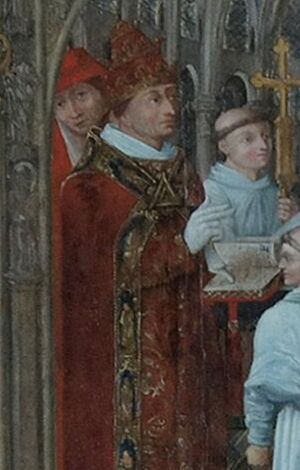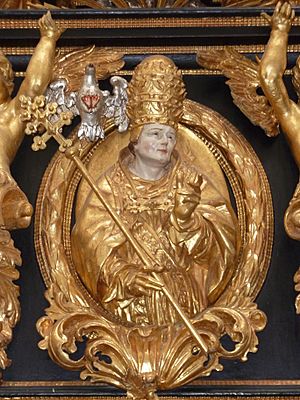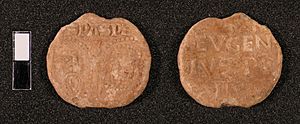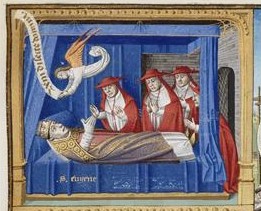Pope Eugene III facts for kids
Quick facts for kids Pope Blessed Eugene III |
|
|---|---|
| Bishop of Rome | |

Miniature of Eugene III
|
|
| Church | Catholic Church |
| Papacy began | 15 February 1145 |
| Papacy ended | 8 July 1153 |
| Predecessor | Lucius II |
| Successor | Anastasius IV |
| Orders | |
| Ordination | 1135 |
| Consecration | 18 December 1145 |
| Personal details | |
| Birth name | Bernardo |
| Born | 1080 Pisa, Republic of Pisa, Holy Roman Empire |
| Died | 8 July 1153 (aged 72–73) Tivoli, Papal States, Holy Roman Empire |
| Previous post | Abbot of San Anastasio alle Tre Fontane (1140–45) |
| Sainthood | |
| Feast day | 8 July |
| Venerated in | Catholic Church |
| Beatified | 28 December 1872 Rome, Papal States by Pius IX |
| Attributes |
|
| Patronage |
|
| Other Popes named Eugene | |
Pope Eugene III (born Bernardo; around 1080 – 8 July 1153) was the leader of the Catholic Church and the lands it controlled from February 15, 1145, until his death in 1153. He was the very first Cistercian monk to become a pope.
When the city of Edessa fell to Muslim forces in 1144, Pope Eugene called for the Second Crusade. This crusade aimed to take back Edessa, but it was not successful. Eugene III was later recognized as a saint and was beatified in 1872 by Pope Pius IX.
Contents
Early Life and Becoming a Monk
Bernardo was born near the city of Pisa in Italy. We don't know much about his family, except that his father was named Godius. Some people think he came from a noble family, but others believe he had more humble beginnings.
In 1106, he worked as a canon (a type of priest) in the Pisa cathedral. Later, he became a subdeacon in 1115. From 1133 to 1138, he helped manage the finances of the Pisa archdiocese.
Between 1134 and 1137, Pope Innocent II made him a priest. Bernardo was inspired by a famous monk named Bernard of Clairvaux. In 1138, Bernardo joined the Cistercian Order at the Clairvaux Abbey in France. A year later, he returned to Italy to lead a Cistercian community. In 1140, Pope Innocent II made him the abbot (leader) of the S. Anastasio alle Tre Fontane monastery outside Rome.
Becoming Pope
Bernardo was chosen as pope on February 15, 1145. This was the same day his predecessor, Lucius II, died. Pope Lucius II had been injured during a conflict with the Roman Senate. Bernardo took the name Eugene III.
People thought Bernardo was a "simple, gentle, and quiet" person. They didn't expect him to become pope. One reason he was chosen was that the job was very difficult and dangerous at the time. He was also a friend and student of Bernard of Clairvaux, who was a very important church leader.
Bernard of Clairvaux was surprised by the choice. He wrote to the cardinals (church leaders who elect the pope), saying, "May God forgive you what you have done!" He felt that Bernardo was just a "rustic" (a simple country person) and not ready for such a high position. Despite these comments, Eugene III didn't seem to hold a grudge against Bernard. In fact, Bernard often gave advice and guidance to Pope Eugene.
The cardinals, however, didn't like Bernard's influence over the new Pope. They felt that Eugene should listen to them, as they had elected him. This disagreement about who had more power – the Pope or the cardinals – continued throughout Eugene's time as pope.
Challenges as Pope
For most of his time as pope, Eugene III could not live in Rome. This was because of a man named Arnold of Brescia. Arnold believed the Pope should only have spiritual power, not political power over lands. The citizens of Rome, influenced by Arnold, set up their own government.
Eugene III asked for help from nearby cities and from King Roger II of Sicily. With their help, he was able to return to Rome for a short time. However, he soon had to leave again in March 1146 because of disagreements with the Roman citizens. He stayed in other Italian cities and then traveled to France.
The Second Crusade
In 1144, the city of Edessa (now Urfa in Turkey), which was one of the Crusader states, fell to the Turks. In response, Pope Eugene III sent out a special message called a "papal bull" in December 1145. This message, named Quantum praedecessores, called on Louis VII of France to start another crusade.
Later, in 1146, Bernard of Clairvaux convinced King Conrad III of Germany and many nobles to join the crusade. The Second Crusade was a very difficult journey. After traveling for a year, the army gave up their fight after only five days of trying to take back land. They did not regain any land from the Muslims. The crusaders lost many soldiers and supplies. This was seen as a big failure for the Christian forces.
Church Reforms and Return to Italy
While in Europe, Eugene III held important meetings called synods in Paris, Rheims, and Trier in 1147. These meetings focused on improving the lives of priests and other church leaders. He also supported the writings of Hildegard of Bingen, a famous German abbess and writer.
In June 1148, Pope Eugene III returned to Italy. He still couldn't go back to Rome because Arnold of Brescia was still very popular there. Eugene settled in Tusculum, a town close to Rome, in April 1149. There, he met King Louis VII of France and his wife, Eleanor of Aquitaine, who were returning from the failed crusade. They were having problems in their marriage because of the difficulties of the crusade. Eugene tried to help them, but his efforts were not successful. Two years later, he agreed to end their marriage.
Eugene stayed in Tusculum until November 1149. With help from the King of Sicily, he was able to enter Rome again. But the people of Rome were still against his political power, so he had to leave in June 1150. Emperor Frederick I Barbarossa promised to help Eugene against the rebellious citizens, but this help never arrived.
Pope Eugene III died in Tivoli on July 8, 1153. Even though the people of Rome didn't like his efforts to control their city, they still respected him as their spiritual leader. He was buried in the Vatican with great respect. He continued to wear the simple clothes of a Cistercian monk under his papal robes until his death.
Veneration

The people of Rome quickly saw Eugene III as a very religious and humble person. His tomb became famous because people believed miracles happened there. This led to the process of him becoming a saint. Pope Pius IX officially recognized him as "Blessed" in 1872.
See also
 In Spanish: Eugenio III para niños
In Spanish: Eugenio III para niños
- Cardinals created by Eugene III
- Knights Templar



